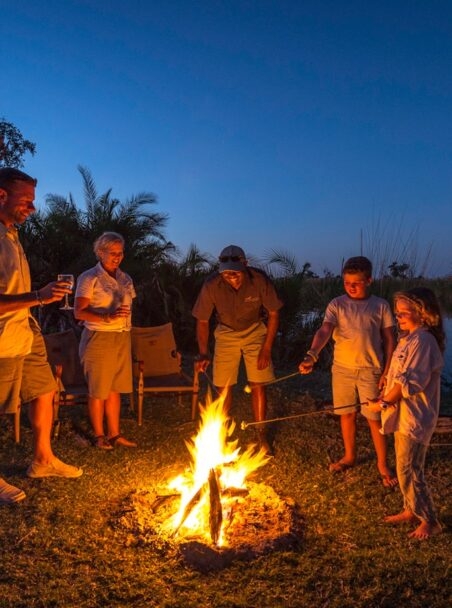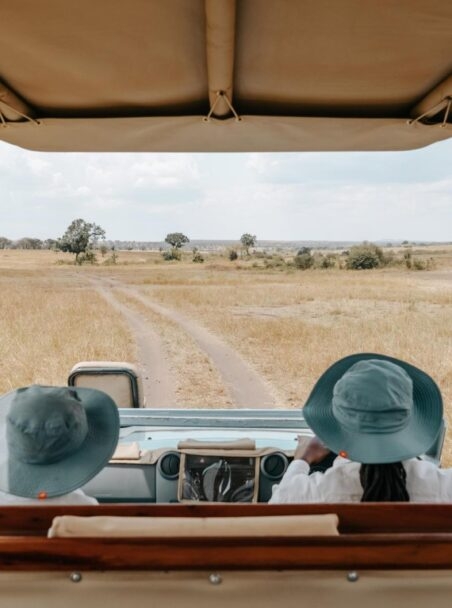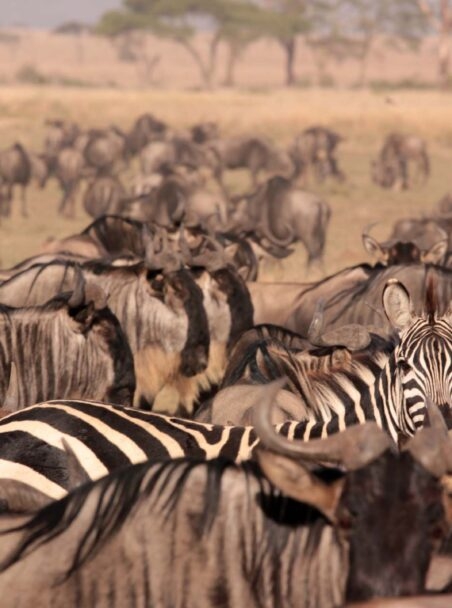Going on safari in Africa is a truly life-changing travel experience. Your first safari is something you’ll never forget, whether you choose to visit East African countries like Kenya and Tanzania or head further south to Botswana and South Africa. Nothing compares to spotting legendary species like the Big Five in their natural habitats.
But before you check this off your bucket list, there’s a lot to think about. Where exactly should you go? What should you pack? What season is best? Luckily, our travel designers are here to help. We’ve compiled their expert tips and advice to create the ultimate guide for first-time safari-goers. Read on to find out everything you need to know.
What do I need to know before going on safari?
Before you go on safari in Africa, it’s important to carefully plan and prepare for your trip. You have to decide what country and region to visit, where to stay, what clothes to pack and what equipment to bring. You should also know more or less what to expect on a typical day.
It can be tough to figure all this out on your own – especially if you’ve never been on safari before. To help you prepare in every possible way, our travel designers have answered some of the most common questions they get about safaris in Africa.
How do I plan my first safari?
The best way to plan an amazing first safari is to enlist the experts. Our travel designers have first-hand experience, with dozens of safaris under their belts. They know all the details and insider secrets needed to design a seamless trip, so you can forget about the logistics and just enjoy the experience.

What’s the best time to go on safari in Africa?
The best time to go on safari depends entirely on your interests and priorities. The wide variety of destinations in Africa means you can enjoy an excellent safari at any time of year, as long as you consider weather conditions and seasonal events specific to each place.

For example, the dry season (generally from June to October) is often the best time for safaris, since animals tend to concentrate around scarce water sources. And if you want to witness a certain event like the Great Migration or the flooding of the Okavango Delta, you’ll need to time your trip carefully.

How long should your first safari be?
The length of your trip will also depend on your interests. For the safari itself, we generally recommend spending 3–4 nights in one place. But if you also want to enjoy other experiences – like beaches, cultural excursions or wine tastings – you’ll need to build them into your itinerary as well.

For instance, if you choose to go on safari in South Africa, you might also want to visit Cape Town or the Winelands. And if you’re visiting Kenya, it’s a great idea to combine a trip to the Maasai Mara with exciting activities in Lewa.

What does a typical day on safari look like?
Most African safaris involve game drives in the morning and/or afternoon, with free time in between to relax back at camp. Expect to wake up early for sunrise wildlife sightings, and prepare for the exhilarating – and sometimes dusty – experience of riding through the wilderness in an open-sided vehicle.

The best safari camps and lodges offer just the right combination of luxury and immersion in nature. Some have pools, gyms and exceptional restaurants for you to enjoy when you’re not out exploring. Many first-timers are surprised by how luxurious tented camps can feel; you don’t have to sacrifice comfort to experience an authentic safari.

What should you pack for a safari?
The first rule of preparing for a safari is to pack light. Try to bring only the basics to make travel smoother – especially if your trip includes multiple destinations. We recommend bringing plenty of layers for chilly morning game drives, ideally in neutral colours like beige to blend into the environment and avoid scaring off animals.

As far as equipment goes, you might want to bring a good camera. If so, make sure you also have charging cables and a portable power bank. We also suggest packing a wide-brimmed hat, a waterproof jacket, sunglasses, a swimsuit, binoculars and a torch (flashlight). Most camps will provide the latter two items, but it’s always nice to have your own.

Where should I go on safari for the first time?
It’s hard to go wrong with a safari in Africa, but the destinations below are especially well suited to first-timers. Our favourite destinations for family trips include activities to keep kids of all ages entertained and family-friendly safari lodges, while our top spots for honeymoons and trips for two offer more privacy.
Some of the best places for first-time safaris are national parks like the Kruger and the Serengeti, which are publicly owned areas protected by the government. Private game reserves like Sabi Sands are also fantastic options, as are wildlife concessions like Mombo. Privately owned or operated areas like these are generally less crowded and more exclusive.
When deciding where to stay on safari, you’ll usually have a choice between tented camps and luxury lodges. Tented camps allow you to get up close to nature without sacrificing comfort, and are sometimes even mobile to follow the wildlife. Luxury lodges tend to have more facilities and activities available, which makes them wonderful for families.
We’ve asked our travel designers to share their top picks for first-time safaris. These are some of their favourite destinations, with insider tips to help you make the most of each.
1. Kenya
Kenya is undoubtedly one of the best destinations for your first safari, with a vast array of landscapes and classic activities for you to enjoy. Here you can witness the legendary Great Migration in the Maasai Mara, and see how the Lewa Wildlife Conservancy is helping to save endangered rhinos and zebras from extinction.

This country is ideal for families with older children, with plenty of activities and opportunities to learn about the local Maasai and Samburu cultures. We recommend staying at Lewa House, Kichwa Tembo Tented Camp or Sala’s Camp, each of which promises an unforgettable introduction to the safari experience.
Need to know: Average temperatures in Kenya range from 20-30°C (68-86°F) depending on the region. The annual rainfall varies significantly, with Nairobi receiving about 900mm (35 inches) and more in the highlands. Kenya is home to approximately 36,000 elephants, one of the largest populations in Africa.

2. Tanzania
If you want to complement your first safari with endless natural wonders, Tanzania is hard to beat. This country is paradise for adventurous travellers who might want to climb Mount Kilimanjaro or meet chimpanzees in the Mahale Mountains, in addition to seeing spectacular wildlife and witnessing the famous river crossings of the Great Migration.

Honeymooners can combine a classic Serengeti safari with the beautiful beaches of Zanzibar and the luxurious Xanadu Villas. And if you’re wondering where to stay in Tanzania, look no further than the Nyasi Tented Camp or any of the fantastic camps and lodges in Singita Grumeti.
Need to know: Tanzania’s climate features temperatures averaging 23-31°C (73-88°F), with coastal areas being warmer. The country receives 500-1,500mm (20-59 inches) of rain annually, concentrated in two rainy seasons (November–December and March–May) .There are over 1.5 million wildebeest in the Seregenti, famous for their annual migration.

3. South Africa
South Africa is an all-round destination for every type of traveller, but it’s especially great for first-time safari-goers. Beyond the world-class wildlife viewing in Kruger National Park and Sabi Sands Game Reserve, this country is also bursting with lovely lodges like Chitwa Chitwa and Singita Lebombo – the latter of which is perfect for a romantic getaway.

Families looking to experience their first safari can visit the malaria-free Madikwe Game Reserve and stay in the spacious suites of Molori or Madikwe Safari Lodge. Honeymooners can add a visit to Cape Town, the Winelands or even the Seychelles: an idyllic archipelago known for its pristine beaches.
Need to know: South Africa’s average temperature varies by region, from 10-30°C (50-86°F). Rainfall patterns are diverse, with the eastern region receiving over 1,000mm (39 inches) and the west being much drier. The country is home to around 18,000 white rhinos, the largest population in the world.

4. Botswana
If getting off the beaten track and seeing as much wildlife as possible sounds like the perfect first safari, then Botswana is for you. It has several private concessions that provide unparalleled privacy and personal service, putting them at the top of our list for an adventurous honeymoon in Africa.

Some of our favourite spots are Moremi Game Reserve and Mombo Concession, that sit within the epic Okavango Delta. First-time safaris here can include not only game drives but also exploring by boat or mokoro (a traditional dug-out canoe). Stay at Wilderness Vumbura Plains, Xigera Camp or Wilderness DumaTau for the optimal introduction to Botswana.
Need to know: The average temperature in Botswana ranges from 22-35°C (72-95°F) during the hotter months. Annual rainfall is typically between 250-650mm (10-25 inches), peaking in summer (December–March). In the Okavango Delta there’s over 130,000 elephants, a crucial sanctuary for the species.

Responsible safari practices and wildlife conservation
Responsible safari practices and wildlife conservation in Africa preserve natural habitats, protect wildlife and uplift communities. These practices include making sure game drive groups are always small, to minimise overwhelming wildlife and minimising environmental disruption, or lighter footprint safari options such as walking safaris.
It’s also important to work closely with local communities, collaborating with tourism initiatives that can support local people. Safari revenue can also go some way to fund anti-poaching patrols and wildlife protection programs. The day to day operations of sustainable safari camps will avoid single-use plastics, use renewable energy and strict water management programmes will be in place.
Ready to start planning your first safari?
Whatever you want from your first safari adventure, our team of experts are ready to help
First time safari FAQs
Choosing where to go on your first safari will mostly depend on who you are travelling with. For example, Kenya and South Africa are great destinations for younger families, older teenagers will enjoy the adventure of Tanzania and Botswana is a wonderful spot for romantic, secluded, luxurious lodges and camps.
Safari clothing should be in neutral colours, to help you blend in and not startle wildlife. If you’re travelling during the winter (which generally runs from June to August) you will need to pack warm clothes, including a coat and hat, for early game drives as it can be very chilly early in the morning. Keep an eye on the weather and be sure to pack rain coats if appropriate and if you plan to hike, bring closed toe comfortable walking shoes or boots. Most places in Africa throughout the year will have some strong sunny spells, so bring the right type of protection: sun hat, sun screen, quick dry fabrics, long sleeves and trousers.
Hopefully you will get the chance to see all of the big five; rhinos, buffalos, lions, elephants and leopards. In addition there will be plenty of plains game, giraffes, zebras, antelopes and hippos. The birdlife is incredible in Africa, there’s so many incredible species such as enormous ostriches, marabou storks, secretary birds, fish eagles and lilac breasted rollers. For those trying a walking safari you will also get to see minute creatures such as insects and reptiles.




















